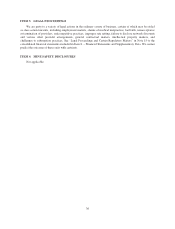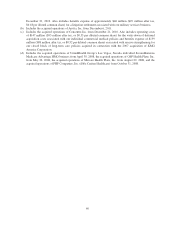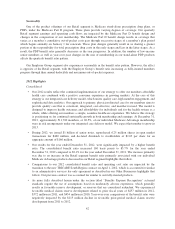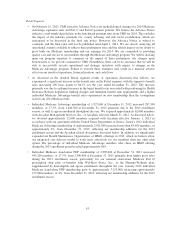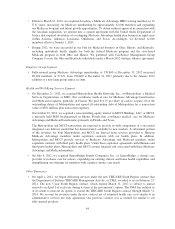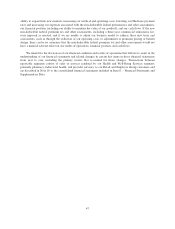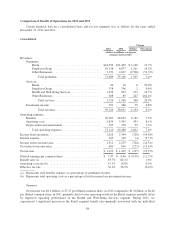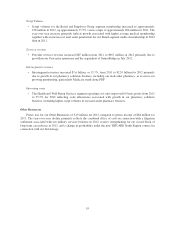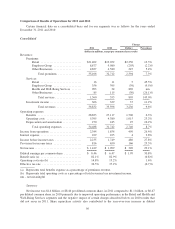Humana 2012 Annual Report Download - page 56
Download and view the complete annual report
Please find page 56 of the 2012 Humana annual report below. You can navigate through the pages in the report by either clicking on the pages listed below, or by using the keyword search tool below to find specific information within the annual report.establishment of federally facilitated or state-based exchanges for individuals and small employers
(with up to 100 employees) coupled with programs designed to spread risk among insurers; the
introduction of plan designs based on set actuarial values; the establishment of a minimum benefit ratio
of 85% for Medicare plans; and insurance industry assessments, including an annual premium-based
assessment and a three-year $25 billion commercial reinsurance fee. The annual premium-based
assessment levied on the insurance industry is $8 billion in 2014 with increasing annual amounts
thereafter, growing to $14 billion by 2017, and is not deductible for income tax purposes, which will
significantly increase our effective income tax rate in 2014. The National Association of Insurance
Commissioners, or NAIC, is continuing discussions regarding the accounting for the insurance industry
premium-based assessment and may require accrual and associated subsidiary funding consideration
for the first two years of the assessment in 2014 followed by annual accruals thereafter. The NAIC
guidance is contradictory to final GAAP guidance issued by the FASB in July 2011, which requires
annual accrual of the insurance industry premium-based assessment in the year in which it is payable.
The Health Insurance Reform Legislation also specifies benefit design guidelines, limits rating and pricing
practices, encourages additional competition (including potential incentives for new market entrants) and
expands eligibility for Medicaid programs. In addition, the law will increase federal oversight of health plan
premium rates and could adversely affect our ability to appropriately adjust health plan premiums on a timely
basis. Financing for these reforms will come, in part, from material additional fees and taxes on us and other
health plans and individuals beginning in 2014, as well as reductions in certain levels of payments to us and other
health plans under Medicare as described herein.
In addition, certain provisions in the Health Insurance Reform Legislation tie Medicare Advantage
premiums to the achievement of certain quality performance measures (Star Ratings). Beginning in 2012,
Medicare Advantage plans with an overall Star Rating of three or more stars (out of five) were eligible for a
quality bonus in their basic premium rates. Initially quality bonuses were limited to the few plans that achieved
four or more stars as an overall rating, but CMS has expanded the quality bonus to three Star plans for a three
year period through 2014. Star Ratings issued by CMS in October 2012 indicated that 99% of our Medicare
Advantage members are now in plans that will qualify for quality bonus payments in 2014, up from 98% in 2013.
Further, the percentage of our Medicare Advantage members in plans with an overall Star Rating of four or more
stars, including one five star plan, increased to 40%. Plans that earn an overall Star Rating of five are
immediately eligible to enroll members year round. Beginning in 2015, plans must have a Star Rating of four or
higher to qualify for bonus money. Notwithstanding successful historical efforts to improve our Star Ratings and
other quality measures for 2012 and 2013 and the continuation of such efforts, there can be no assurances that we
will be successful in maintaining or improving our Star Ratings in future years. Accordingly, our plans may not
be eligible for full level quality bonuses, which could adversely affect the benefits such plans can offer, reduce
membership, and/or reduce profit margins.
As discussed above, implementing regulations and related interpretive guidance continue to be issued on
several significant provisions of the Health Insurance Reform Legislation. Congress may also withhold the
funding necessary to implement the Health Insurance Reform Legislation, or may attempt to replace the
legislation with amended provisions. Given the breadth of possible changes and the uncertainties of
interpretation, implementation, and timing of these changes, which we expect to occur over the next several
years, the Health Insurance Reform Legislation will change the way we do business, potentially impacting our
pricing, benefit design, product mix, geographic mix, and distribution channels. In particular, implementing
regulations and related guidance are forthcoming on various aspects of the minimum benefit ratio requirement’s
applicability to Medicare, including aggregation, credibility thresholds, and its application to prescription drug
plans. The response of other companies to the Health Insurance Reform Legislation and adjustments to their
offerings, if any, could cause meaningful disruption in the local health care markets. It is reasonably possible that
the Health Insurance Reform Legislation and related regulations, as well as future legislative changes, in the
aggregate may have a material adverse effect on our results of operations, including restricting revenue,
enrollment and premium growth in certain products and market segments, restricting our
46


